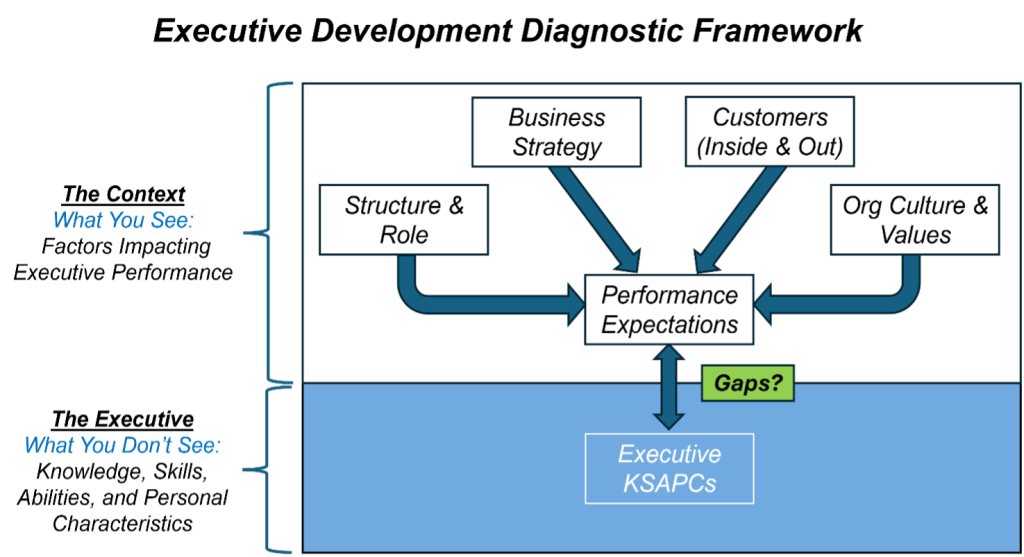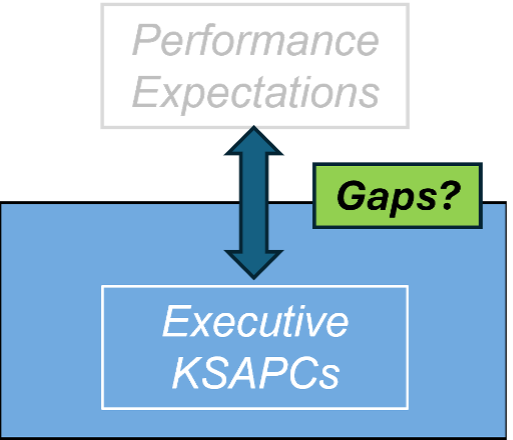Context Matters! Diagnosing and Improving Executive Performance
By S. Richard Park, Ph.D.
We see it all the time…
A senior executive who owns a significant piece of overall business performance is struggling. They are simply not equipped to handle these challenges. Pride, inexperience, blind spots, and indifference are just a few of the many reasons that hinder their progress…and business performance suffers along the way.
That’s just the nature of executive leadership.
It’s natural to focus on what executives are doing (or not doing). But their behavior is deeply embedded in the context of an organization. That context is critical (and often messy) when you’re committed to developing executives.
What is “The Context”?
There will always be debate regarding the key factors impacting executive performance and development. Debate is a vital component in advancing any profession – including executive development. But here’s what works for us:

We’ll address each element of this framework on the pages that follow.

Executive roles are unique in many ways. Here are just a few:
- They contribute to two teams. The obvious one is the team they lead. Not so obvious is the team of their peers. Finding the right approach for each is rarely simple for those holding executive roles.
- They create and execute organizational strategy. These activities will invariably introduce personal and/or interpersonal conflict. Personal values and relationships are regularly challenged as a result.
- Structure as an impediment. In a perfect world, structure follows strategy. In reality, structure is often suboptimized for a variety of reasons (risk, culture, talent deficits, customer relationships, unclear roles, etc.)
- Uncertainty and change. If an executive expects their role to be static, they need to stop. The three items listed above will require a nimble incumbent by themselves…and they are just a few of the complexities facing executives. Executive roles morph regularly.
Some important questions to consider:
- Do executives clearly understand the nature of their roles (see above)?
- What Structural (Role) changes have impacted them?
- How do they characterize key relationships with both teams? Do others see it the same way?
- Have they explored changes for the team they lead? Structure? Role? Other?
- What is at the root of performance challenges from the perspective of their manager? Peers? Others?

Strategy Design
“Business Strategy” is a choice. It’s how a business chooses to facilitate progress toward a different, defensible, and/or valuable position in their current (or maybe a different) market. A few of the market features typically considered when creating strategy are competitors, threat of substitutes, suppliers, legal/regulatory environments, acquisition (v. expansion), vertical integration, geography, external cultural differences and many more.
Strategy Execution
It doesn’t get any easier once business strategy is set. Markets never stay still. Executives are uniquely responsible for anticipating and planning for future changes, monitoring and assessing the potential impact of unanticipated changes, acting (or not), ripple effects across the industry, and preparing their peers and teams even when the outcome is uncertain.
Some important questions to consider:
- Does the organization have a strategy? What is it? What were the key market factors considered in its design?
- Is it well-known and understood? Is there an execution plan (short- and long-term)?
- What are their anticipated market changes? How will executives react?
- How nimble are executives when faced with unanticipated changes?
- Are projected market changes realistic? Are proposed changes valuable?
- Does each executive have a strategy for their org? Is there an execution plan?
o Have peer executives and team members bought in?
o Is the strategy driving strategic and operational dialogue within the teams?
o Do team members understand and connect their work to the strategy
o How is it promoted within the team? How often?

Customers are those who rely on a product or service offered by executives and their company. Internal customers are typically peers…external customers and their needs should be defined by strategy.
The quality, timing, and resources required of critical internal deliverables are often negotiated at the executive level…and can become a source of frustration for many.
Some important questions to consider:
- Who are the company’s customers?
- What are their needs from us as a company?
- What role does my organization play in delivering external customer needs?
- How well do peers and team members understand the above 3 questions?
- Who are internal customers? Why? Why not?
- What do internal customers need from their organization?
- How well do team members understand their internal customers?

“Org Culture and Values” represents common employee actions that are promoted by most members of the workforce. Cultural behavior tends to evolve naturally in the absence of clarity; value-consistent behavior tends to be prescribed by the organization.
In instances where executives prescribe “culture and values” they are faced with balancing 1) what type of environment employees want and/or 2) what is good for the business…and these don’t always coincide. (See Talent Alignment’s “Culture Change – A CEO’s Perspective” for more on this topic.)
Some important questions to consider:
- Do culture and values balance workforce needs and business strategy? Should they? What needs to change?
- Are interpersonal or interdepartmental battles left to linger? If so, why?
- Can executives describe culture and values with common behaviors? Is their description accurate? Do all executives support them?
- Do they approach talent decisions with values in mind (e.g., succession, potential, performance, and talent reviews)?
- To what extent do each executive’s values “fit” company culture and values? Are they willing to expend the effort to change theirs?
- Is there a valuable subculture for their organizations? What are the risks associated with each?
- How do they promote culture- and values-consistent behaviors in their organizations?

Like most other employees, executives will typically discuss their managers’ expectations at some point early in the company’s performance cycle. Ideally, these expectations will fall into two categories:
- WHAT they should accomplish for the period. These are often in the form of Specific, Measurable, Attainable, Relevant, Time Bound and (S)trategic goals …SMART(S) goals.
- HOW they should go about accomplishing them. These are often in the form of knowledge, skills, abilities, and personal characteristics (KSAPCs…see the next section for definitions.)
Some important questions to consider:
- Do all executives have goals? Have they bought in to them? Are they held accountable for key skills?
- Are goals and skills well-known (peers, team, board, manager, customers, etc.)? Are some goals shared or contingent on others? If so, what are they and with whom are they connected?
- Is the workforce held accountable for goals? What are the rewards/consequences associated with goals?
- Are goals SMART(S)? Which are most difficult and why?
- Are executive goals, skills, etc. cascaded appropriately?
- Do executives believe their expectations will benefit the organization? Why/why not?
- Do members of executives’ organizations understand the importance of their goals? How they connect to business strategy?

“KSAPCs” is a commonly used acronym for underlying employee capability. This taxonomy helps executive development experts to 1) consider a broader array of competencies across four levels and 2) identify relevant development solutions. The table below details each component of the taxonomy.

“Gaps?” represents a set of executive capabilities that have degraded executive performance.
Some important questions to consider:
- What KSAPC’s are required to deliver expectations? Are there specific ones that limit performance?
o Driven by Role? Strategy? Culture? Customers? Business Knowledge? - What if anything has been done to address them?
o If nothing, why? - Are executives receptive to and capable of personal change?
o Aware of their own capabilities?
o Do they readily accept the need for development?
o Can they easily alter approaches to “fit” social situations?
o Is feedback seriously considered and leveraged? - Are gaps prioritized and actioned? (See Appendix A for a sample development planning template.)
- What development solutions are appropriate?
o Learning (Reading, Video, In Person, etc.)
o Coaching
o Mentor
o Special Projects
o Volunteer Assignments
Final Thoughts
An organization’s preferred market position is defined, planned, promoted, and executed by executives exclusively. In this context, their collective and individual competence is tied directly to their organization’s performance. Nobody/nothing else even comes close.
While this post touches on many of the issues associated with executive performance and development, it only represents a place to start when faced with developing an entire executive team or its individual members. Where it goes from there has lies somewhere between “art”, “science”, and “a passion for change.”
Thanks to Eric Paul, ACC and Paul O’Beirne for their contributions to this article.

Author Bio
S. Richard Park, Ph.D. partners with executive business leaders to create a competitive advantage through people. He has held specialized roles in assessment design and validation, workforce development, rewards, performance management, culture, and organizational effectiveness.
Rick’s passion for business strategy prompted him to transition into HR executive roles supporting CEOs and other executives with global responsibilities. He has worked in technology (Dell, Microsoft), manufacturing (Georgia-Pacific, KSB SE & Co. KGaA), and HR consulting (AON).
Today, Rick leads an HR consulting firm called Talent Alignment, LLC. He brings a practical approach to the firm’s clients by focusing on delivering a competitive advantage through people. Rick’s ability to speak to executive leaders in business terms is much appreciated by his partners and their clients.
Rick coauthored #1 best-selling book called “When Work Works”. His chapter “‘So What Do You Do?’ The Answer Your CEO Will Love!” explains how HR and business leaders can design work processes to engage employees in creating a competitive advantage for their organizations. His chapter and the book are available here.
Rick earned a Ph.D. in Industrial/Organizational Psychology to help prepare him for a career in HR, talent management, and OE.
His volunteer work involves coaching incarcerated individuals and groups. He enjoys playing guitar, cycling, announcing high school sports, and home projects. He and his wife, Lisa, enjoy traveling, exploring restaurants, and spending time with their two adult children, Lauren and Michael (and their dog, Dempsey).
Rick can be reached at [email protected] and www.talentalignment.net.
Appendix A
Sample Development Planning Template
